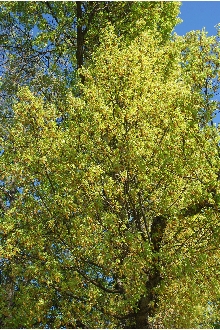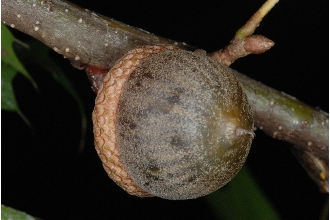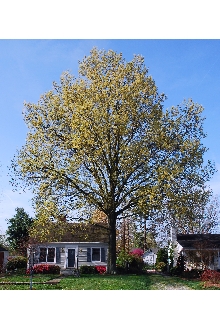Pin Oak
Scientific Name: Quercus palustris Münchh.

| General Information | |
|---|---|
| Usda Symbol | QUPA2 |
| Group | Dicot |
| Life Cycle | Perennial |
| Growth Habits | Tree |
| Native Locations | QUPA2 |
Plant Guide
Use soil moisture sensors to measure the soil moisture of Pin Oak.
Fact Sheet
Uses
Even though the wood is heavy, strong, and hard, pin oak is typically used for fuel wood, wood pulp, and railroad ties, since it tends to warp. Due to this species’ form, adaptability, growth rate, longevity, and fall foliar display, it is popular for ornamental usage. Pin oak is utilized by many game species, especially wood ducks, white-tail deer, and wild turkey. Due to its use by these highly sought after animals, pin oak is commonly planted for food plots.
Status
Please consult the PLANTS Web site and your State Department of Natural Resources for this plant’s current status (e.g. threatened or endangered species, state noxious status, and wetland indicator values).
Description
Pin oak is a moderately large tree with normal heights ranging from 70 to 90 feet with diameters between 2 and 3 feet. Trees reaching 120 feet tall with 5-foot diameters are occasionally encountered on good sites. The bark of this tree is smooth, reddish to grayish-brown during the juvenile period, becoming darker and shallowly fissured as the tree growth slows with age. The lower branches of pin oak are prostrate to descending, with smooth, slender, reddish-brown twigs. Clusters of pointed buds are located at the tips of twigs. Three to five inch alternate leaves have 5 to 7 points or lobes with bristled tips and deep C-shaped sinuses. The leaves change in color from a dark green to a deep scarlet red in fall. The leaves are deciduous but will usually persist on the tree into winter. The flowers of pin oak emerge soon after new leaves unfold in spring (April to mid-May). The acorns that develop are roundish, short stalked, 3/8 to 1/2 inches long, and capped with a thin and shallow saucer-like cup. The acorns will take 16 to 18 months to develop from pollination to maturity. When mature the acorn turns light brown to reddish-brown, and will drop from September to November. In 30 to 35 year old stands of pin oak, 4,000 to 20,000 sound acorns per acre yields have been documented. There are 410 acorns per pound. Pin oak is often confused with scarlet oak (Q. coccinea) due to similar appearance. Scarlet oak is an upland species that prefers soils with good drainage on dry sites. Robert H. Mohlenbrock USDA NRCS 1991. Southern Wetland Flora @USDA NRCS PLANTS
Adaptation and Distribution
Distribution
Distribution
Pin oak’s native range spans from Rhode Island, Pennsylvania, Michigan, to Kansas south to North Carolina and northern Arkansas, This tree grows under a wide range of site conditions, but is a true bottomland tree, It is seldom found growing above elevations of 800 feet, or on sloped ground, Pin oak grows in practically pure stands with good growth rates on wet, shallow sites with heavy soils that drain poorly, On better quality sites it will often grow larger, but is normally out competed by other species, Use soil moisture sensors to measure the soil moisture of Pin Oak., For a current distribution map, please consult the Plant Profile page for this species on the PLANTS Website,
Establishment
Both seed and stump sprouts are sources of natural regeneration for pin oak. Although viable acorns sink, this species is often dispersed by water, as well as animals, wind, and gravity. In areas that are regularly flooded, acorn damage by insects is reduced and germination is typically faster than most other species. Since there is more than adequate annual seed yields and adequate moisture on the forest floor in spring, it is not uncommon to see seedlings blanketing the ground under pin oak. Under nursery production conditions, mature acorns are placed on raised beds in fall or spring, but germination will not occur until spring. Shoot elongation begins about the same time as leaf out of established trees and continues until fall. Seedlings are distributed by most nurseries as 1 year old bareroot stock for field plantings, but balled and burlapped saplings are distributed for ornamental uses.
Management
Pin oak typically requires management only during the first few years after outplanting to a permanent site. Weed competition and deer browse must be managed in many locations. Site preparation to control weeds the year prior to outplanting will pay dividends in increased growth rate. Contact herbicides, used according to the label, and/or control by tillage are most commonly used. There are a variety of deer control products that may be useful such as tubes or mesh sleeves over the seedling. Weeds and deer control require repetitive action and maintenance to be effective.
Plant Traits
Growth Requirements
| Temperature, Minimum (°F) | -33 |
|---|---|
| Adapted to Coarse Textured Soils | No |
| Adapted to Fine Textured Soils | Yes |
| Adapted to Medium Textured Soils | Yes |
| Anaerobic Tolerance | Medium |
| CaCO3 Tolerance | Low |
| Cold Stratification Required | Yes |
| Drought Tolerance | Low |
| Fertility Requirement | Medium |
| Fire Tolerance | Medium |
| Frost Free Days, Minimum | 120 |
| Hedge Tolerance | Medium |
| Moisture Use | High |
| pH, Maximum | 6.5 |
| pH, Minimum | 4.5 |
| Planting Density per Acre, Maxim | 800 |
| Planting Density per Acre, Minim | 300 |
| Precipitation, Maximum | 60 |
| Precipitation, Minimum | 32 |
| Root Depth, Minimum (inches) | 30 |
| Salinity Tolerance | Low |
| Shade Tolerance | Intolerant |
Morphology/Physiology
| Bloat | None |
|---|---|
| Toxicity | None |
| Resprout Ability | Yes |
| Shape and Orientation | Erect |
| Active Growth Period | Spring and Summer |
| C:N Ratio | High |
| Coppice Potential | Yes |
| Fall Conspicuous | Yes |
| Fire Resistant | No |
| Flower Color | Yellow |
| Flower Conspicuous | No |
| Foliage Color | Green |
| Foliage Porosity Summer | Dense |
| Foliage Porosity Winter | Moderate |
| Foliage Texture | Medium |
| Fruit/Seed Conspicuous | No |
| Nitrogen Fixation | None |
| Low Growing Grass | No |
| Lifespan | Moderate |
| Leaf Retention | No |
| Known Allelopath | No |
| Height, Mature (feet) | 100.0 |
| Height at 20 Years, Maximum (fee | 40 |
| Growth Rate | Rapid |
| Growth Form | Colonizing |
| Fruit/Seed Color | Brown |
Reproduction
| Vegetative Spread Rate | None |
|---|---|
| Small Grain | No |
| Seedling Vigor | High |
| Seed Spread Rate | Slow |
| Fruit/Seed Period End | Fall |
| Seed per Pound | 410 |
| Propagated by Tubers | No |
| Propagated by Sprigs | No |
| Propagated by Sod | No |
| Propagated by Seed | Yes |
| Propagated by Corm | No |
| Propagated by Container | Yes |
| Propagated by Bulb | No |
| Propagated by Bare Root | Yes |
| Fruit/Seed Persistence | No |
| Fruit/Seed Period Begin | Summer |
| Fruit/Seed Abundance | Medium |
| Commercial Availability | Routinely Available |
| Bloom Period | Spring |
| Propagated by Cuttings | No |
Suitability/Use
| Veneer Product | Yes |
|---|---|
| Pulpwood Product | No |
| Post Product | No |
| Palatable Human | No |
| Palatable Browse Animal | Low |
| Nursery Stock Product | Yes |
| Naval Store Product | No |
| Lumber Product | Yes |
| Fuelwood Product | High |
| Fodder Product | No |
| Christmas Tree Product | No |
| Berry/Nut/Seed Product | No |















